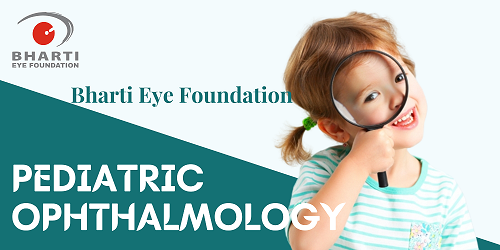Pediatric ophthalmology – Bharti Eye Foundation

Many children and newborns have a variety of vision problems. The sooner these issues are identified and addressed, the better. Pediatric ophthalmology focuses on the treatment of children’s eye problems.
Pediatric ophthalmology aids in the early detection of vision-related problems in children. If an eye defect is not repaired within six months of birth, a child will be blind for life. Throughout the first six months of life, the optic nerve is still developing, and if eye problems are not treated at this time, irreversible damage may occur.
Similarly, young children may have a variety of vision problems that they are unaware of. This is why it is critical to include paediatric ophthalmology in the curriculum.
The Department of Ophthalmology’s paediatric ophthalmologists provide comprehensive care for children’s eye problems as well as adult strabismus, including diagnosis, treatment, and management (deviated eyes). We focus on inherited eye diseases such as congenital (present at birth) glaucoma and cataracts.
Also Read: Oculoplasty
What happens during your child’s eye exam?
Your child will first have a series of eye exams to determine their overall eye health. Your child’s exam will most likely last several hours. The tests are usually performed by two or three of our doctors. During the first round of tests, we will discover the following:
- How well your child notices nearby and distant objects. If your child cannot read, we can assess his or her vision using tests that may include pictures or shapes.
- Depth perception in your child.
- The ease with which your child’s eyes align and move together when tracking items (done by an orthoptist).
- Your child’s peripheral vision, also known as side vision.
- In the exam’s second section, we may:
- Use eye drops to dilate or widen your child’s pupils.
- After about 30 minutes, an ophthalmologist will examine the interior of your child’s eyes through the widened pupils to see if there are any problems and whether your child requires corrective lenses.
- Examine your child’s eyes with special lights and lenses to determine whether or not he or she requires glasses and to rule out any problems.
What Is a Pediatric Ophthalmologist’s Role?
Optometrists and ophthalmologists can both examine children’s eyes, test their vision, and prescribe glasses or contacts if necessary. Optometrists are not doctors, but they can prescribe medication for certain eye conditions. All eye disorders and problems identified and treated by ophthalmologists.
Typically, young toddlers are unable to describe or respond to medical problems. Pediatric ophthalmologists who skilled at treating children in a way that makes them feel safe and at ease. They employ child-sized equipment and conduct eye exams tailored to the child’s developmental stage.
To become an ophthalmologist, paediatric ophthalmologists must first complete medical school and then additional training in eye disorders. They are then given additional training in identifying and treating paediatric eye disorders. The education process lasts 13 years and includes the following steps:
- Medical Bachelor of Science (four years)
- A year-long internship
- Ophthalmology residency (three years)
- Pediatric ophthalmology fellowship (at least one year)
Reasons to Consult with a Pediatric Ophthalmologist
During routine checkups, your child’s vision will examined by their paediatrician or family doctor. They may refer you to a paediatric ophthalmologist if they or you notice a problem with your child’s eyes. The following symptoms point to a child having an eye problem:
• Light sensitivity
• Crossed or roving eyes
• Watery or red eyes, persistent pus, or crust
• They frequently massage their eyes.
• To see, they are squinting and tilting their heads.
• A comprehensive eye examination recommended by doctors for
• Prematurely born children
• Those born with a disorder that increases their chances of having eye problems, such as Down syndrome.
• Children with learning disabilities or delays in development
• Those who have had visual difficulties as a child.
Let’s put an end to it with paediatric ophthalmology!
Comprehensive eye exams should be a regular part of your child’s healthcare routine. While squinting and drooping eyelids are obvious, parents may struggle to identify problems such as lazy eye and refractive errors. Especially since the majority of children do not notify their parents about the problem because they lack the ability to recognise that their visual skills have changed. It is thus the primary responsibility of parents to notice any changes in their children’s behavioural patterns, such as close-up TV viewing, excessive straining to read from a book, or unexpectedly poor performance in school.
If any of these sound familiar, it’s time to consult with a paediatric ophthalmologist about your child’s eye health.
Pediatric Ophthalmology – Preserving our children’s future vision
At Bharti Eye Foundation, paediatric ophthalmology taken seriously, with expert specialists and surgeons working around the clock to ensure that our next generation’s vision is adequately protected. Prescription glasses and eye exercises are initially used to treat children who squint or have slow eyes. Dr. S Bharti’s hospital was one of the first to use eye yoga as a rehabilitation technique. Parents who have children born out of wedlock between relatives or who have both parents who wear glasses due to refractive problems encouraged to bring their children for an evaluation.
Clinical knowledge
Pediatric ophthalmologists are experts in the development of the visual system in children as well as illnesses that interfere with visual development. Pediatric ophthalmologists also have extensive knowledge of the various eye diseases that affect children. Pediatric ophthalmologists trained to perform complex eye surgery as well as treat children’s vision problems with glasses and medications. Many ophthalmologists and other physicians refer young patients to a paediatric ophthalmologist for assessment and treatment of ocular problems due to the
needs of children. Children with head rotations, head tilts, squinting of the eyes, or preferred head postures (torticollis) are frequently referred to a paediatric ophthalmologist for screening, in addition to those with obvious vision abnormalities. Pediatric ophthalmologists frequently see adults who have problems with their eye movements.
What type of education do paediatric ophthalmologists have?
- Pediatric ophthalmologists are eye doctors who specialise in children’s eyes.
- At least four years of medical school
- A one-year internship in medicine or surgery
- At least three years of additional ophthalmology residency training
- At least one year of additional paediatric ophthalmology fellowship training
THE BEST CHILDCARE IS PROVIDED BY PEDIATRIC OPHTHALMOLOGISTS.
The Pediatric Ophthalmology and Strabismus programme at the Bharti Eye Foundation diagnoses and treats a wide range of eye illnesses and vision problems in children and adolescents, as well as adults with Strabismus.
Children are not just miniature adults. They can’t always express how they feel. They are not always capable of responding to medical inquiries or being patient and cooperative during a medical examination.
Pediatric ophthalmologists understand how to assess and treat children while remaining calm and cooperative. Furthermore, paediatric ophthalmologists use equipment that specifically designed for children. The majority of paediatric ophthalmologists’ offices specifically designed for children. Toys, videos, and reading materials for children may found in waiting rooms and examination rooms. This helps to create a secure and comfortable environment for your child.
If your child’s doctor recommends having his eyes checked, a paediatric ophthalmologist has the most extensive and comprehensive training, as well as the most expertise in working with children and treating children’s eye problems.
Also Read:





